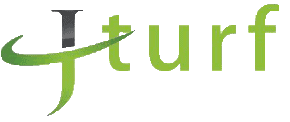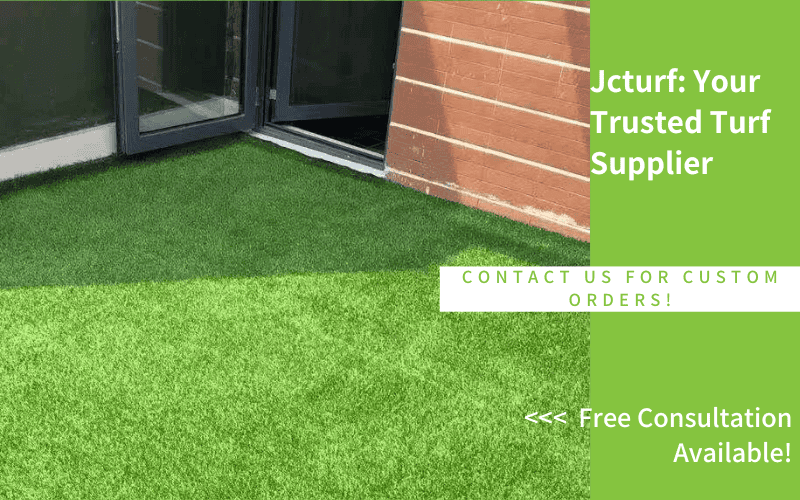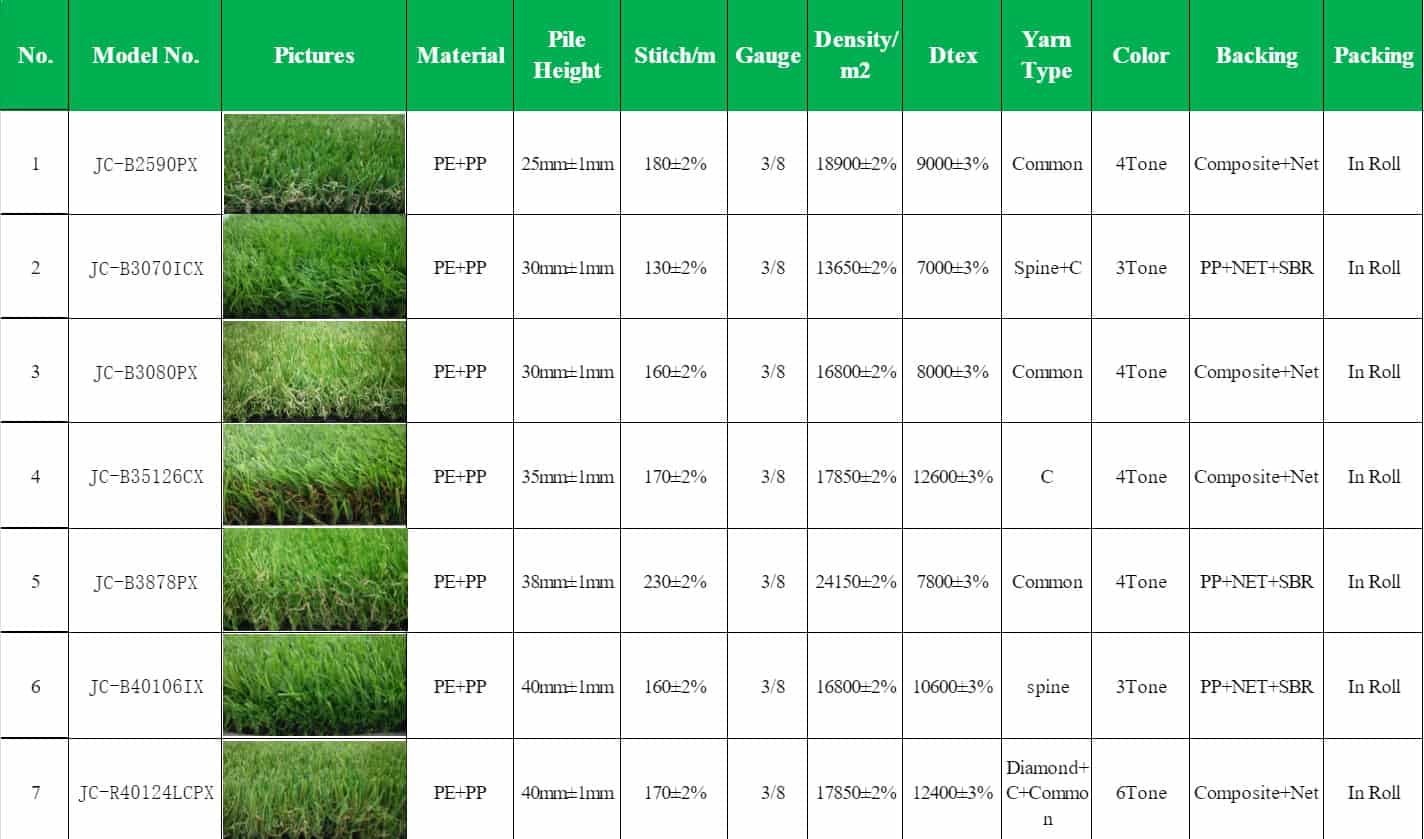Municipal artificial grass is a durable, low-maintenance solution for public spaces like parks, playgrounds, and sports fields. It offers cost savings, environmental benefits, and year-round consistency. This article covers its key advantages, ideal applications, selection tips, and cost considerations. We’ll also guide you through regulations, installation, maintenance, and when to replace the turf. Finally, we’ll compare municipal artificial grass with real grass to help you choose the best option for your public space.
What Is Municipal Artificial Grass?
Designed for public spaces, municipal artificial turf is a durable, low-maintenance alternative to natural grass. It is commonly used in parks, playgrounds, streetscapes and sports fields and is an efficient and sustainable choice.
What sets municipal artificial grass apart is its durability. Engineered to withstand the demands of high-traffic areas, its fibers are more robust and durable than residential turf, capable of handling continuous foot traffic, frequent cleaning, and occasional heavy machinery. The reinforced backing ensures the grass stays in place and maintains its integrity over time, outperforming natural grass in spaces where it would typically struggle.
Benefits of Using Artificial Grass in Municipal Spaces
Municipal artificial grass offers several key advantages that make it a practical choice for public spaces, from cost savings to environmental benefits.
Cost Savings and Reduced Maintenance: Artificial grass eliminates mowing, watering, and fertilizing, leading to significant savings in water and labor costs. It reduces the long-term expense of maintaining natural grass in public spaces.
Environmental Benefits: Artificial grass conserves water and eliminates the need for pesticides and fertilizers, helping municipalities reduce water consumption, especially in drought-prone areas, while minimizing chemical use.
Consistent Appearance Year-Round: Artificial grass stays green year-round, unaffected by weather. It won’t turn brown in droughts or become muddy after rain, keeping public spaces vibrant all year.
Durability and Safety: Designed to withstand heavy foot traffic, pets, and sports, municipal artificial grass remains durable over time. In playgrounds, added padding enhances safety, making it ideal for children’s areas.
UV Resistance: The fibers are treated to resist sun damage, ensuring the grass maintains its color and appearance over time, even under harsh sunlight.
Weather Adaptability: Crafted to withstand a diverse array of weather circumstances, it possesses the capability to endure both blistering heat and sub-zero temperatures, maintaining its original shape and vibrant color throughout.
Drainage System: One of the key features for public spaces is an advanced drainage system, preventing water pooling and ensuring the grass remains functional even after heavy rain.
Customization Options: Municipalities can choose from various textures, colors, and heights of grass to match their specific needs. For example, areas prone to high foot traffic might require thicker, denser turf, while playgrounds could benefit from softer padding underneath the grass for extra safety.
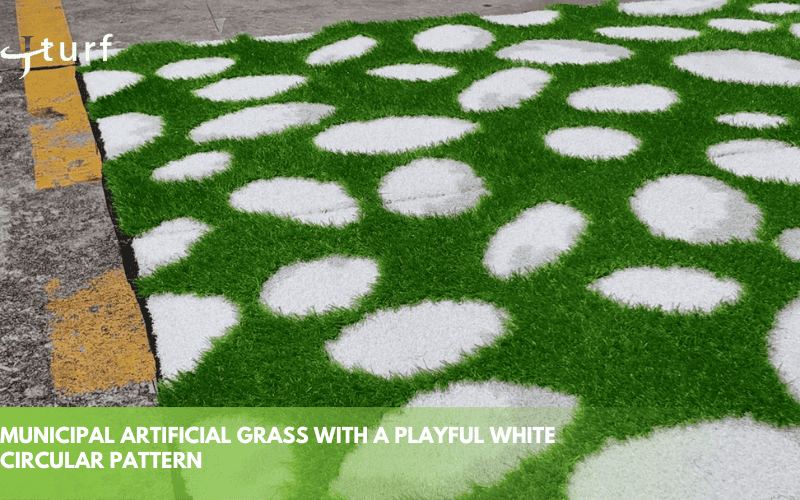
Ideal Applications of Municipal Artificial Grass
Municipal artificial grass is perfect for a variety of public spaces, offering durability, low maintenance, and year-round vibrancy.
Parks, Plazas, and Recreational Areas
Artificial grass enhances parks, urban plazas, and gardens by providing a green, low-maintenance alternative. It stays lush year-round, cutting down on watering, mowing, and fertilizing. In cities like Los Angeles, it helps reduce water usage and maintenance costs while keeping public spaces inviting.
School Playgrounds and Sports Fields
For schools, artificial grass offers a durable, safe surface for playgrounds and sports fields. It requires minimal maintenance and can handle heavy use. Its even surface reduces trip hazards, and it’s ideal for sports fields, offering consistent performance throughout the year.
Urban Green Spaces, Streetscapes, and Roads
Artificial grass is ideal for urban spaces, improving streetscapes and public areas with low-maintenance greenery. It can be placed along roads, between pavers, or in walkways, providing aesthetic value and reducing upkeep costs. It also prevents weed growth, making it a practical solution for high-traffic areas.
Municipal Artificial Grass on Concrete, Soil, and Dirt
Artificial grass can be installed on concrete, soil, or dirt, providing a vibrant solution for areas where natural grass struggles. It works well in plazas, over compacted soil, or in difficult spaces, offering a green, functional surface without the need for regular maintenance.
Navigating Municipal Regulations and Legal Considerations
Before installing municipal artificial grass, it’s crucial to understand the legal landscape. Each municipality has specific laws, regulations, and permits that govern its use in public spaces.
Municipal Artificial Grass By Law: Key Compliance Points
When using artificial grass in public spaces, ensure you comply with:
- Environmental Impact: Many regions require proof that the turf meets sustainability standards, such as water conservation.
- Zoning and Land Use: Some areas may have restrictions on where artificial grass can be installed.
- Safety Standards: Compliance with safety regulations is essential, especially in playgrounds or sports fields.
Is There a Municipal Artificial Grass Ban?
In some regions, artificial grass is restricted or banned due to environmental concerns, such as water usage or heat retention. Areas facing water shortages may limit synthetic turf installation. It’s essential to check for any bans or restrictions in your area to avoid non-compliance.
Do You Need a Permit for Municipal Artificial Grass?
In most cases, yes, a permit is required. Permits ensure your installation follows local regulations, including zoning, safety, and environmental standards. Larger installations, like parks or sports fields, may require additional approvals.
Key Factors in Applying for a Municipal Artificial Grass Permit
When applying for a permit, consider:
- Project Scope: Larger projects require more detailed documentation.
- Zoning Compliance: Ensure your installation aligns with local zoning codes.
- Environmental Concerns: Some regions may require proof of water conservation or sustainability.
- Safety Measures: Safety certifications are necessary for high-traffic or recreational areas.
By addressing these factors, you can streamline the approval process and ensure compliance with local laws.
How to Choose the Right Municipal Artificial Grass for Your Project
Choosing the right artificial grass for municipal projects should be based on the intended use and functional requirements of the area.
Selecting Based on Different Applications
The type of artificial grass for municipal projects should be chosen according to the specific use case. Each application has different material, density, and functional requirements:
Playgrounds: Safety is the top priority. Choose grass that is certified for safety standards and pair it with shock-absorbing pads to reduce the risk of falls. The turf should be soft, non-slip, and have good drainage.
Sports Fields: Choose turf that meets the specific needs of the sport, such as FIFA or World Rugby certified grass, emphasizing durability and ball rebound performance. The grass should have a shorter height (20-35mm), and rubber granules can be used as infill to enhance performance.
Roads and Streetscapes: This application focuses on aesthetics and low maintenance. Turf with a medium height (30-40mm) is ideal, and it should be UV-resistant to withstand sunlight. Additionally, the drainage system should be effective to prevent water accumulation.
Urban Spaces: For parks or public squares, the grass needs to balance aesthetics with durability. Choose high-density turf with natural colors to withstand high foot traffic.
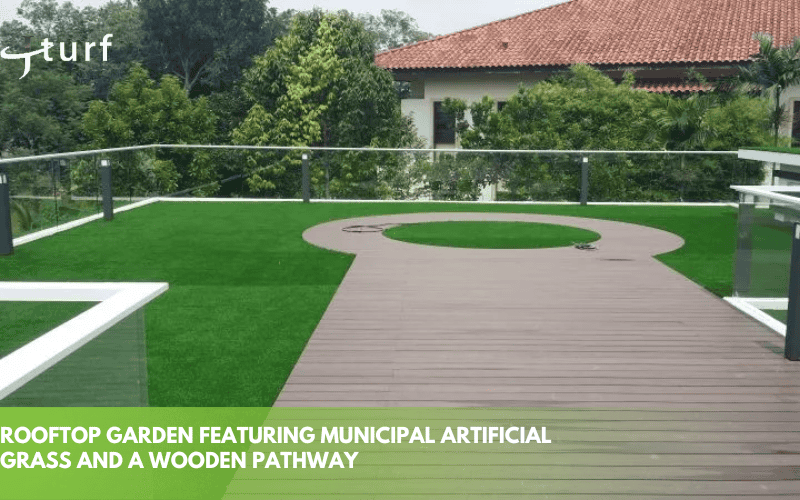
How to Assess Durability, Drainage, and Performance of Municipal Artificial Grass
Durability: You can assess the durability of the grass by looking at the fiber strength (measured in denier) and the stitch density (stitches per square meter). Turf with a higher denier (e.g., 8000-12000) and a higher stitch density (15,000-20,000 stitches per square meter) is better suited for high-traffic areas.
Drainage Performance: High-quality turf should have an efficient drainage system with large drainage holes to ensure quick drying after heavy rainfall.
Heavy Use Performance: Perform a tuft bind test to evaluate how well the grass fibers hold up under stress. Turf for high-traffic areas should have a tuft bind strength of over 30 Newtons and maintain its shape over time.
Municipal Artificial Grass Infill and Base Material Selection
Municipal Artificial Grass Infill
- Silica Sand: Suitable for low-budget projects, provides stability at a low cost, but can increase surface hardness.
- Rubber Granules: Commonly used for sports fields, offering better cushioning and elasticity, but needs regular checks to prevent infill loss.
- Organic Fill (such as coconut or cork): Environmentally friendly and has a lower surface temperature, ideal for playgrounds or hot climates, but comes at a higher cost.
Municipal Artificial Grass Base
- Crushed Stone Base: Affordable, with good drainage properties, suitable for most municipal projects.
- Concrete Base: Ideal for high-traffic areas like sports fields, though additional drainage designs are necessary to prevent water accumulation.
- Shock Absorption Pad: Recommended for playgrounds or sports fields. The thickness (10-20mm) should be chosen based on safety standards.
Understanding Coverage Needs for Large Areas
Large-scale projects like parks or public squares require careful planning for coverage and installation details:
Measurement and Planning: Accurate site measurements are crucial, taking into account irregular shapes and edge treatments. It’s recommended to allow for 5-10% extra material to account for installation losses.
Seaming Technology: Seamless technologies (such as heat welding or professional stitching) help ensure aesthetic consistency and reduce the risk of cracking over time.
Zoning Design: For large areas, use different types of turf based on function. For example, long, decorative grass can be used in rest areas, while shorter, more durable grass should be used in active areas, optimizing both cost and performance.
Maintenance Access: Ensure maintenance pathways are built into the design to allow for easy cleaning and repair access, extending the lifespan of the turf.
Municipal Artificial Grass Price
When considering municipal artificial grass for public projects, understanding the breakdown of costs is crucial for effective budgeting. Costs can vary depending on factors like size, quality, and materials.
Breakdown of the Initial Costs of Municipal Artificial Grass Installations
The initial cost of installing municipal artificial grass typically includes several components:
Material Costs: The grass itself is often the most significant expense. The price can range from $20 to $80 per square meter, depending on the quality, density, and type of turf selected.
Labor Costs: Installation labor can range from $10 to $30 per square meter. The complexity of the project, including site preparation and the installation of additional features like drainage systems, will influence this cost.
Base Preparation: Preparing the site is an essential step and often accounts for 30-40% of the total installation cost. This includes leveling the ground, ensuring proper drainage, and sometimes adding a shock-absorbing layer for playgrounds or sports fields.
Factors Influencing the Cost (Size, Quality, Materials)
Several factors can affect the price of municipal artificial grass installations:
Size of the Area: Larger installations generally have a lower per-square-meter cost due to economies of scale. However, additional costs such as transportation and seam installation for large areas can add up.
Quality of Turf: Higher-quality turf, designed to withstand heavy use and harsh environmental conditions, will cost more upfront. This includes UV-resistant grass, high-density fibers, and better drainage systems. Although these options are pricier, they often reduce long-term maintenance costs.
Materials Used: The choice of materials, such as infill and base materials, plays a significant role in the overall price. Organic fills, like cork or coconut husk, are more expensive than traditional silica sand but may be required for specific applications like playgrounds.
Municipal Artificial Grass for Playgrounds Cost
Playground turf usually ranges from $50 to $100 per square meter, depending on the quality of the turf and the additional safety measures required.
Beyond the turf, you’ll also need to account for the installation of safety features like soft fall zones, specialized infill materials (e.g., rubber), and ensuring the turf meets specific safety certifications like EN1177.
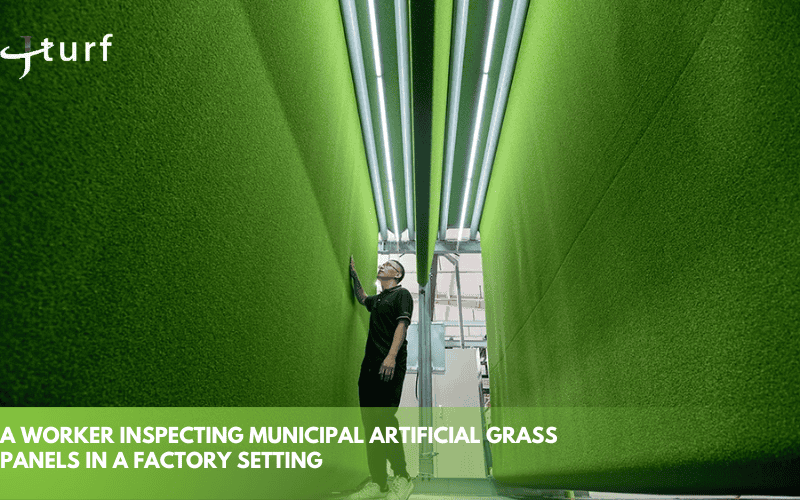
Installation and Maintenance of Municipal Artificial Grass
Proper installation and ongoing maintenance are essential to ensuring that municipal artificial grass performs well and lasts for years.
Municipal Artificial Grass Installation Steps
The installation of municipal artificial grass requires careful planning and precise execution. Here’s how to approach it:
- Site Preparation: The first step is clearing the site of any debris, rocks, or vegetation. The ground should be leveled to create an even surface, ensuring proper drainage. If the area has drainage issues, extra work like excavation may be required to prevent water buildup.
- Base Layer: A solid foundation is key. Crushed stone or gravel is typically used for its excellent drainage properties. For high-traffic areas, a thicker base may be needed to ensure the turf stays intact over time.
- Grass Laying: Once the base is ready, the artificial grass is rolled out. It should be laid in sections, with seams carefully aligned to ensure they are discreet and secure. The edges should be trimmed to fit the area precisely and fastened to prevent shifting.
- Infill: After the turf is laid, infill materials—such as rubber granules or silica sand—are spread evenly across the surface. This helps the grass fibers stay upright, improves durability, and enhances drainage.
- Final Touches: The turf is brushed to make sure the infill is well distributed and the grass fibers are standing correctly. Compaction of the surface ensures the turf stays stable and feels natural underfoot.
Municipal Artificial Grass Winter Considerations
Artificial grass is known for its durability, but it requires special care in winter, especially in colder regions. Here’s how to manage it during the colder months:
Winterizing the Turf: Cold temperatures can make the turf more brittle and affect the performance of infill. Before winter, remove leaves, snow, and ice to prevent buildup. A soft brush or leaf blower works well for this.
Preventing Ice and Snow Damage: Excess snow and ice can put stress on the grass fibers and weigh them down. Gently remove snow with a shovel or snow blower, and avoid using salt, as it can degrade the turf over time.
Covering for Protection: For areas like sports fields or playgrounds that may be used less during winter, covering the grass with a tarp or protective cover can help shield it from harsh conditions.
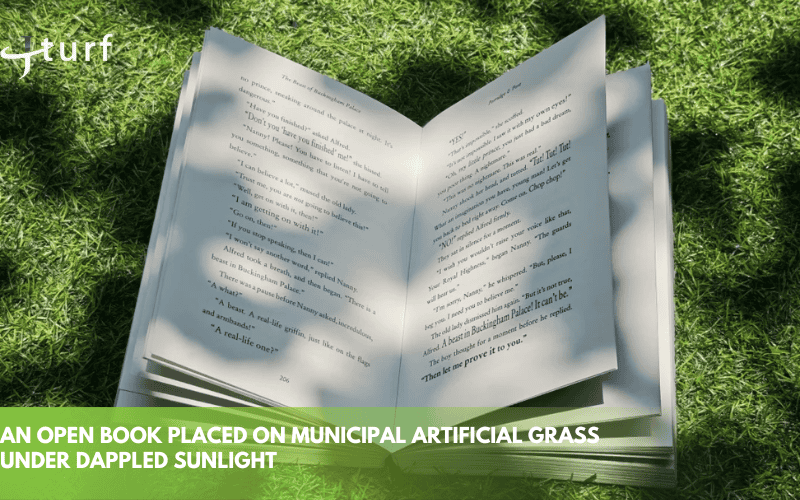
When to Replace Municipal Artificial Grass?
Municipal artificial grass typically needs to be replaced after 8 to 15 years, depending on usage, climate, and the quality of the turf. Signs that it’s time for replacement include fading or discoloration, excessive wear in high-traffic areas, and drainage issues like water pooling. Regular inspections can help identify when the turf’s performance has deteriorated, ensuring timely replacement before it becomes a safety or aesthetic concern.
Municipal Artificial Grass vs. Real Grass: Which Is Better for Public Spaces?
Municipal artificial grass and real grass both options have their benefits and challenges, and understanding these differences can help municipalities make the best choice for their specific needs.
| Factor | Municipal Artificial Grass | Real Grass |
| Performance | Durable, maintains appearance year-round | Requires care to maintain healthy appearance |
| Durability | Highly durable, withstands high traffic and weather extremes | Prone to wear in high-traffic areas, needs reseeding |
| Maintenance | Low maintenance: occasional brushing, cleaning, and infill | High maintenance: regular mowing, watering, fertilizing |
| Cost | Higher upfront cost, but long-term savings | Lower installation cost, but ongoing maintenance costs |
| Environmental Impact | Saves water, but made from synthetic materials | Supports local ecosystems, absorbs CO2, and cools environment |
| Aesthetic | Consistently green, no seasonal changes | Can struggle in extreme weather, may become patchy |
| Installation Flexibility | Can be installed on soil, concrete, or other surfaces | Requires suitable soil and proper care for installation |
| Suitability | Ideal for high-traffic areas, sports fields, and urban spaces | Best for low-traffic areas with proper care |
Reliable Municipal Artificial Grass Suppliers for Public Projects
Choosing the right artificial grass for municipal projects is crucial to achieving a sustainable, low-maintenance, and visually appealing public space. As an experienced artificial turf supplier and manufacturer, JCturf offers a range of high-quality municipal artificial grass products designed to meet the unique needs of public areas, from sports fields and playgrounds to urban parks and streetscapes.
Our products are engineered for durability, offering excellent performance in high-traffic areas, and are backed by competitive pricing. Whether you’re looking to save on maintenance costs or enhance the aesthetic value of your public spaces, we have the perfect solution for your needs.
